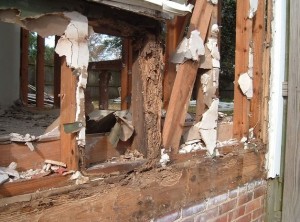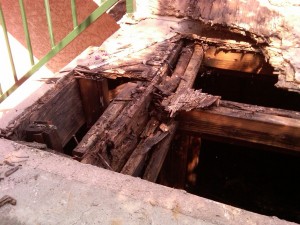 Everyone dreams of buying and owning their own house. We spend years dreaming about and saving for a home where we can raise a family, and come home to after a hard day at work. No doubt, it’s a huge responsibility, but it is one which we are more than ready to take. It’s like a dream come true when we finally start living in our own house, a result of our hard work and years of planning. And once we’re in our dream home, we don’t want to have to worry about that dream being reduced to dust. However, one teeny, tiny insect that has the ability to cause many a sleepless night is the termite. Nothing strikes fear into a homeowner’s heart quite like termites.
Everyone dreams of buying and owning their own house. We spend years dreaming about and saving for a home where we can raise a family, and come home to after a hard day at work. No doubt, it’s a huge responsibility, but it is one which we are more than ready to take. It’s like a dream come true when we finally start living in our own house, a result of our hard work and years of planning. And once we’re in our dream home, we don’t want to have to worry about that dream being reduced to dust. However, one teeny, tiny insect that has the ability to cause many a sleepless night is the termite. Nothing strikes fear into a homeowner’s heart quite like termites.
Termites are the cause of billions of dollars in damages each year. According to the National Pest Management Association, about $5 billion dollars a year is caused by termite damage in the U.S. alone. Termite damage is not only expensive but it’s also difficult to fix. They can chew holes in our furniture, support beams, all studs and floor joints, and also do damage to our foundation. What’s worse is quite often we don’t even know they’re there until the damage has already been done. Known as “silent destroyers,” termites often do their damage from the inside out. Some signs of termites include cracked paint on wood surfaces, sawdust piles, hollow-sounding wood, discarded wings, and mud tubes leading to the foundation of our home. Because these signs are so subtle, it can be really hard to identify a termite problem before it becomes a full-blown termite infestation. Termites move in looking for food and because our home is built out of their food source, it’s a goldmine for them!
Termites have been around for a very long time and are one of the most successful and prolific species on the planet. Worldwide, the destructive insects cause roughly $40 billion a year in damages to homes and other wooden structures! Termites are active 24 hours a day, seven days a week,  silently feeding on the cellulose found in our wooden articles. Termites are present in 70% of countries across the world and outnumber humans 10 to 1! And the worst part? Most pest infestations and accompanying damage are considered maintenance issues by insurance carriers. In other words, the insurance company’s position is that you could have prevented the mishap by eradicating the pesky bugs before they ate you out of home! Thus the poor homeowner has to pay for all the repairs. Considering the population of termites today, and the extent of damage they cause, a homeowner may well be on his way to bankruptcy!
silently feeding on the cellulose found in our wooden articles. Termites are present in 70% of countries across the world and outnumber humans 10 to 1! And the worst part? Most pest infestations and accompanying damage are considered maintenance issues by insurance carriers. In other words, the insurance company’s position is that you could have prevented the mishap by eradicating the pesky bugs before they ate you out of home! Thus the poor homeowner has to pay for all the repairs. Considering the population of termites today, and the extent of damage they cause, a homeowner may well be on his way to bankruptcy!
The below article, published on an incident on termite damage would highlight the graveness of this issue.
Termites chewing up Kitchener’s Laurentian Hills neighbourhood
Posted: Aug 12, 2014
Residents in Kitchener’s Laurentian Hills area are battling a termite colony that has taken up residence in their back yards and are asking for the city’s help to battle the bugs.
The termites are chewing apart trees, sheds, fences and even people’s homes.
“It’s something that will eventually spread to the rest of the city if it isn’t addressed in the near future,” said Stephen Dewar, whose house is affected by termites.
On Monday, he asked city councillors to help him and his neighbours fight the invasion.
“Right now it’s contained to a city block, so it hasn’t crossed the road yet. All the houses that are affected either about each other or back on to each other,” said Dewar.
The infestation in Laurentian Hills is confined to one block of 23 homes, essentially a rectangular island of homes on Briargate Drive and Greenock Drive. In that block, 20 homes were infected and seven of those homes have already been treated for termites.
Dewar said he discovered the infestation in the spring, after the city inspector found termite evidence on his property. At the time, he learned that some of his neighbours had known about termites in the area for as long as three years.
Dewar said there is a bylaw that requires him to have his property treated by a professional exterminator within 30 days or he will face a fine from the city.
“They basically told us it’s the homeowner’s responsibility,” he said.
But Dewar said the exterminators he approached told him they could only use chemicals that work as repellents to try to keep the termites out of his house. The exterminators wouldn’t be able to kill the colony, because the chemicals that can be legally used in Ontario won’t kill the insects.
“So the problem isn’t going to go away, and in fact it’s likely to spread to the rest of the city,” said Dewar.
Dewar said it would cost between $2,000 to $5,000 to treat the outside of his property, and from $5,000 to $8,000 – or more – to treat the inside of his property. The treatment is only good for one year, he said.
Dewar has asked city staff to look into new ways to get rid of the termite colony, not to enforce the bylaw and to offer financial help to people in the Laurentian Hills who are dealing with the termites.
Council on Monday decided to continue enforcing the bylaw, but will consider offering financial assistance to the homeowners.
“We have to look holistically, though, not just at this issue but at rats and the infestation of emerald ash borer, other potential infestations as well,” said Coun. Dan Glenn-Graham.
“We can’t afford to support this kind of long-term funding,” he told council.
“Because if we were to do it for some, we have to be willing to do it for all.”
 Although many people think termites have only negative impacts, in nature, they make many positive contributions to the world’s ecosystems. Their greatest contribution is the role they play in recycling wood and plant material. Their tunneling efforts also help to ensure that soils remain porous, contain nutrients, and are healthy enough to support plant growth. Thus, what we need to look for is an answer which would help solve the problem of termite infestation, while at the same time not harming the termites in any way. Sounds impossible, doesn’t it? C Tech Corporation provides precisely that!
Although many people think termites have only negative impacts, in nature, they make many positive contributions to the world’s ecosystems. Their greatest contribution is the role they play in recycling wood and plant material. Their tunneling efforts also help to ensure that soils remain porous, contain nutrients, and are healthy enough to support plant growth. Thus, what we need to look for is an answer which would help solve the problem of termite infestation, while at the same time not harming the termites in any way. Sounds impossible, doesn’t it? C Tech Corporation provides precisely that!
C Tech Corporation can offer a solution to overcome this problem. Our product Combirepel™ is an extremely low toxicity and extremely low hazard and eco-friendly rodent aversive. Combirepel™ is available in the form of solid masterbatches, liquid concentrate and in lacquer form. The product is compliant with RoHS, RoHS2, and REACH and is FIFRA exempted. This product acts through a series of highly developed intricate mechanism ensuring that rodents are kept away from the target application.
The fencing and tree guards can be coated withCombirepel™ to protect the trees, shrubs etc. from the damage caused by the grey squirrels. The product can also be incorporated into agricultural films, greenhouse films, plastic mulches used on a large scale in the agriculture as well as horticulture sector in order to avoid damages caused by these squirrels to fruits and vegetables. Also, the products can be directly incorporated in the polymer matrix during processing of pipes and tubing. Combirepel™ does not leach out, thus there is no soil pollution. Groundwater reserves are also not polluted. Also the non-target beneficial species like earthworms, bees etc are not affected.
The product is compliant with ROHS, ROHS2, ISO, REACH, APVMA, NEA, EU-BPR, and FIFRA exempted.
Contact us at technical.marketing@ctechcorporation.com if you’re facing problems with rodents and get best remedies to combat the pest menace.
Also, visit our websites:
http://www.ctechcorporation.com/
http://www.rodrepel.com/
http://www.termirepel.com/
http://www.combirepel.com/
Follow our Facebook pages at:
1] https://www.facebook.com/Combirepel-411710912249274/
2] https://www.facebook.com/Termirepel-104225413091251/
3] https://www.facebook.com/Rodrepel-120734974768048/
Follow us on our Twitter pages at:
1] https://twitter.com/rodrepel
2] https://twitter.com/termirepel
3] https://twitter.com/combirepel

